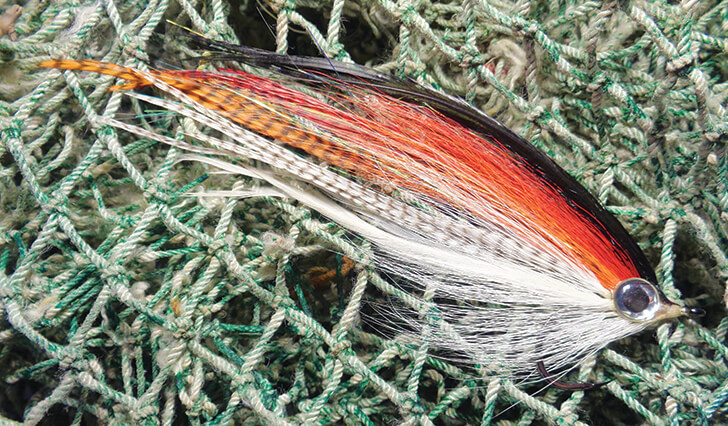By Carlos Hidalgo:
Menhaden are one of the most important baitfish on the Atlantic coast. Bunker, as menhaden are commonly called, are thin when looked at from the top but very wide from the side. Small bunker, referred to as peanut bunker, are easy to mimic with Flat Wings, Hi-Ties or any number of specialized patterns. Flies that represent big bunker, however, pose challenges.
Think of casting a wet mop head, and you’ll get the idea. The other problem is that flies compress when stripped through the water. A fly with a wide profile on the tying vise can end up looking like a strand of spaghetti in the water.
Captain Chris Newsome grew up fishing the lower Chesapeake Bay in Virginia, where bunker make up as much as 80 percent of striped bass diets. As a fly fishing guide, Chris needed to come up with a large bunker fly that was easy to cast and kept its wide profile.
The idea of how to accomplish this came to him one night when he was woken up by his crying young daughter. Instead of tying bucktail and saddle hackles directly on the hook, Chris thought to tie the material onto small pieces of wire, which would then be tied onto the hook. Since the fly is made up with a relatively small amount of material, it easy to cast. The angle of the wires ensures the fly keeps its wide profile in the water. The fly has been very effective for stripers and can be used for any gamefish that feeds on wide-profile baitfish.
Wired Bunker Fly:
- Hook – Tiemco 600SP, size 2/0 to 6/0
- Thread – Danville flat waxed nylon, 210 denier
- Wire – Malin Hard Wire, size 1/0
- Tail – bucktail topped by four saddle hackles tied flat
- Wing – four saddle hackles surrounded by bucktail tied onto ½-inch wire pieces
- Belly – long, thin bunches of bucktail tied onto ½-inch wire pieces
- Eyes – 3-D prismatic, 3/8” to 3/4”
- Glue – Beacon 527
Place a piece of wire in the vise and tie a thin bunch of bucktail onto it. Make several of these units. Next, tie several components made up of four saddle hackles surrounded by bucktail onto pieces of wire. Flashabou can be tied onto each component. Begin by tying a thin amount of bucktail topped by four saddle hackles tied flat onto the back of the hook. Move the thread up the shank and tie a wing component (one with hackles) on top of the hook and a belly component (one with just bucktail) on the bottom of the shank. Keep moving the thread up the hook shank and tie at least two more wing and two more belly units. Bend the wire pieces until satisfied with the fly’s profile. Glue each tie-in point, and finish by gluing eyes onto the sides of the fly.
Contact Captain Chris Newsome at 804-815-4895 or chris@bayflyfishing.com. Check out his website BayFlyFishing.com. Contact Carlos at cah6620@gmail.com if you would like to submit a pattern for consideration in this column or if you would like to order my book, “South Florida’s Peacock Bass.”
